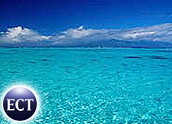
A startling revelation about the number of different kinds of bacteria in the deep sea raises fundamental new questions about microbial life and evolution in the oceans.
In a paper published by the Proceedings of the National Academy of Sciences on Monday, scientists reveal marine microbes may be some 10 to 100 times more diverse than had been previously believed. The vast majority of these microbes were previously unknown, low-abundance organisms that may play an important role in the marine environment as part of a “rare biosphere,” researchers said.
“Along coastal areas that are impacted by huge population growth, one sees a shift in the coastal water systems. Those shifts are not necessarily desireable. The introduction of nitrogen and phosphate can allow [biologists to study] organisms that were not very dominant to out [so that] we could detect those changes in time to do something about it,” lead author Mitchell L. Sogin, director of the Marine Biological Laboratory’s (MBL) Josephine Bay Paul Center for Comparative and Molecular Biology and Evolution, told TechNewsWorld.
New DNA Techniques
These observations blow away all previous estimates of bacterial diversity in the ocean, according to Sogin. Just as scientists have discovered through ever more powerful telescopes that stars number in the billions, he noted, we are learning through DNA technologies that the number of marine organisms invisible to the eye exceeds all expectations and their diversity is much greater than we could have imagined.
Sogin and seven co-authors — from the U.S., The Netherlands and Spain — made their discovery using a revolutionary new DNA technique called 454 tag sequencing. The technique requires only small snippets of genetic code to identify an organism. They produced as many as 25,000 short DNA sequences for microscopic organisms in each sample at eight Atlantic and Pacific sites.
Millions of Species
“Microbiologists have formally described 5,000 microbial ‘species,'” Sogin said. “This study shows we have barely scratched the surface. Over the last 10 to 20 years, molecular studies have shown there to be more than 500,000 kinds of micro organisms. In our new study, we discovered more than 20,000 in a single liter — about one quart — of seawater, having expected just 1,000 to 3,000. The number of different kinds of bacteria in the oceans could eclipse five to 10 million.”
The most unusual sequence tags come from organisms present in low abundance, and these bacteria make up the rare biosphere. The detection of these previously overlooked microbes opens a world of new questions about their role in ecological processes and their evolutionary history.
Earth’s Most Ancient Life Forms
Microbes constitute the vast majority of marine biomass and are the primary engines of Earth’s biosphere. They are the oldest life forms, the primary catalysts of energy transformation, and fundamental to the biogeochemical cycles that shape our planetary atmosphere and environment.
“From an evolutionary perspective, they are of pivotal importance. They were the only kinds of life on Earth for approximately 80 percent of the planet’s history. All multi-cellular life depends upon microbial processes. The microbes can live without us but we are totally dependent upon them for our continued survival,” Sogin said. “Exploration of this newly discovered ‘rare biosphere’ could become a major field of marine biology.”
Rare Microbes in Nature
While a small number of different kinds of bacteria dominated all samples studied, thousands of low-abundance populations represented an overwhelming majority of the novel diversity. The researchers are now asking how and why these many different populations of low abundance organisms exist at all — and why they are still here.
“It’s possible these rare organisms are present in high numbers at some locations and their low abundance at other sites is a consequence of diffusion and dispersal. However, we believe they must have some importance to the marine ecosystem and can theorize a couple of possible roles,” Sogin said.
One is that they are keystone life forms — microorganisms that exist in low numbers but have some important function within the community, producing perhaps some essential compound.
A Zoo of Bacteria
Alternatively, these rare, low-abundance organisms, which are less prone to predation and direct competition with dominant species, may exist throughout the oceans. If environmental change precludes the growth of dominant populations, members of the rare biosphere may take on new importance in ecosystem processes.
“Imagine a world of car manufacturers comprised of giants like Toyota, Ford and Mercedes but with 20,000 other firms making a few vehicles each,” said Jesse Ausubel, the Census of Marine Life Program Director at the Alfred P. Sloan Foundation. “That is how it seems the mysterious microbial world operates. A swimmer taking just a swallow of seawater may be consuming an entire zoo of 1,000 different forms of bacteria.”





















































